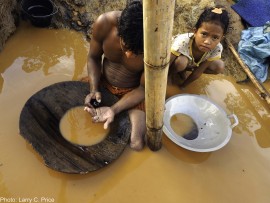Artisanal Small-Scale Gold Mining
Artisanal gold mining refers to small-scale low-tech, informal activities focused on mining and processing ore to recover gold. Although AGM sites are individually small scale, collectively the sector comprises 20 percent of the world’s gold production2. Additionally it releases more mercury into the environment than any other sector worldwide76. The technologies and methods are exceedingly primitive and the ore is usually processed with rudimentary methods that have little to no pollution controls.
The majority of artisanal gold mining sites in the database are in Africa and Southeast Asia, although there is a high concentration of artisanal miners in Latin America as well. It is estimated that artisanal gold mining occurs in as many as 55 countries employing between 10 and 15 million miners2. Artisanal gold mining is a subsistence industry engaged in at the individual level, and is most likely to be prevalent in countries or regions with limited government oversight or regulation of small-scale industrial activities. Small gold mining operations can be started with very little investment or infrastructure and producers can often make 70 percent or more of the price of international gold, a rare economic advantage in small-scale or informal industries3. Gold is an easily traded commodity and prices are generally stable or growing, making it a very attractive subsistence industry for marginalized members of society.
Artisanal gold mining is a small-scale industry, but contributes a large number of polluted sites to the Pure Earth’s database. There are over 200 sites that potentially expose more than 4.2 million people to the risk of toxic pollutants, particularly mercury. There is limited scientific data available to allow calculation of DALYs from mercury exposure at identified sites, although it is the key pollutant in artisanal gold mining. Meanwhile, lead and chromium from artisanal gold mining sites contribute roughly 550,000 to 1.6 million DALYs to the total burden of disease in the 49 countries assessed.
Key Pollutants
Mercury is the top pollutant in artisanal gold mining operations. In the Pure Earth’s database close to 3.4 million people are at risk for exposure. Mercury is a bio-accumulative toxin that is absorbed by fish, birds and other wildlife, contaminating local food chains. It is known to cause neurological damage, especially in fetuses and children. As prevalent and hazardous as mercury is in small-scale mining, other pollutants are also released. Within the database, lead has been found at more than 20 sites, putting close to 250,000 people at risk. Lead is often released in the air when the lead-containing ore is crushed. Lead also causes neurological and developmental damage in children.
Exposure Pathways
The US EPA estimates that approximately 400 metric tons of mercury is released into the air each year from the processing of gold in artisanal gold mining4. Mercury is released during the heating of amalgam, when mercury is evaporated. The mercury vapor is inhaled directly by workers and is absorbed into surrounding surfaces, where it is re-emitted into the air over time. The mercury vapor is also and settles on plants, soil and in waterways nearby. Gold processing is often undertaken in residential areas and done in the open around children and other family members, directly exposing the community to the mercury vapor. Those not directly exposed to the fumes are at risk of ingesting mercury that has been absorbed by waterways, soil or fish. The largest majority of exposures in the Pure Earth’s database are through inhalation of contaminated dust or vapors and ingestion of contaminated water.
2. Ibid.
3. Veiga, M.M., Baker, R. “Protocols for Environmental and Health Assessment of Mercury Released by Artisanal and Small Scale Miners”. Report to the Global Mercury Project: Removal of Barriers to Introduction of Cleaner Artisanal Gold Mining and Extraction Technologies. 2004.
4. “A Practical Guide: Reducing Mercury Use in Artisanal and Small-Scale Gold Mining.” United Nations Environment Programme. 2012. Available at: http://www.unep.org/.../.../UNEP%20Tech%20Doc%20APRIL%202012_120608b_web.pdf




